1995 Oldsmobile Cutlass Supreme turn signal
[x] Cancel search: turn signalPage 7 of 340

Vehicle Symbols
These are some of the symbols you may find on your vehicle.
3.
For example,
these sym%ols
are used on an
original battery:
POSSIBLE A
CAUTION
INJURY
PROTECT EYES BY
SHIELDING
CAUSTIC
BURNS
SPARKS
OR
FLAMES
SPARK
OR
FLAME ,I#$,
COULD
EXPLODE
BATTERY
These symbols are important
for you and
your passengers
whenever your vehicle is
driven:
POWER
WINDOW n-
These symbols
have to do with your lights:
SIGNALS e
TURN
pA;:z
pf
WARNING A
HAZARD
FLASHER
HIGH
LAMPSoR BEAM = =o
FOG LAMPS 3 0 '
These symbols
are on some
of
your controls:
WINDSHIELD
WIPER
'r' -4
WINDSHIELD 6$
WASHER I
WINDSHIELD
DEFROSTER
REAR
WINDOW
DEFOGGER
VENTILATING
b
. FAN
These symbols are used
on
warning and
indicator lights:
CHARGING ,I-1
BAllERY
SYSTEM
BRAKE
(a)
RADIATOR COOLANT
a
ENGINE OIL
PRESSURE Wh
. TEMP OIL
ANTI-LOCK
(@)
BRAKE
Here are some
other symbols
you may see:
FUSE
RADIO
k
VOLUME a
CONDITIONING AIR 43
LIGHTER k
SPEAKER
b
V
Page 83 of 340
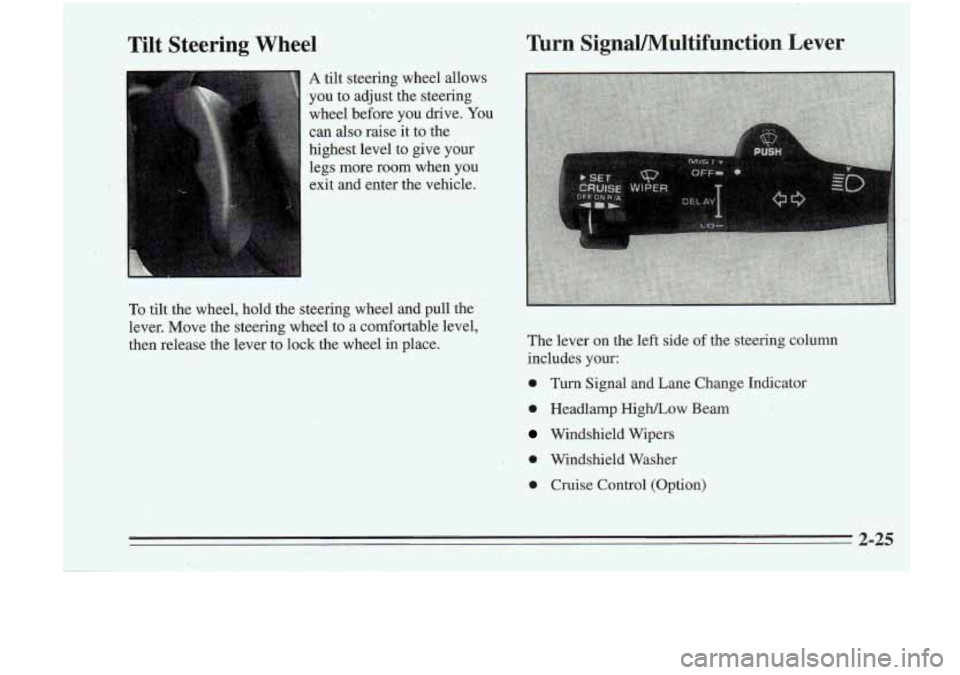
c
Tilt Steering Wheel
A tilt steering wheel allows
you to adjust the steering
wheel before you drive. You
can also raise it to the
highest .level to give your
legs more room when you
e& and enter the vehicle.
To tilt the wheel, hold the steering wheel and pull, the
lever. Move the steering wheel to
a comfortable level,
then release the lever to lock the wheel in place.
Turn SignaVMultifunction Lever
The lever on the left side of the steering column
includes your:
"
0 Turn Signal and Lane Change Indicator
0 Headlamp HighLLow Beam
Windshield Wipers
0 Windshield Washer
0 Cruise Control (Option)
2-25
Page 84 of 340
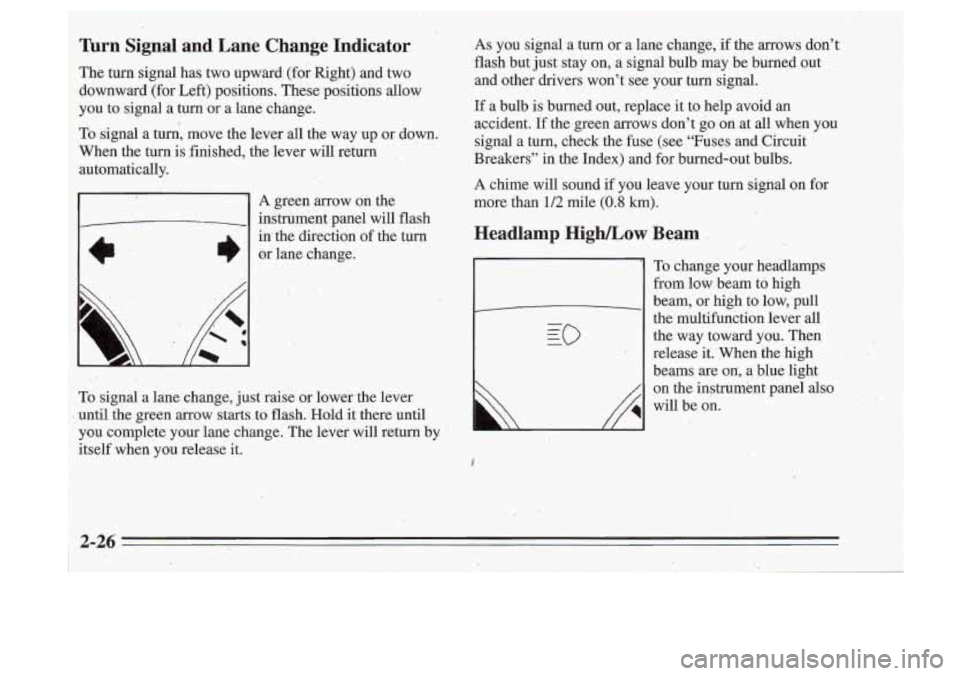
.,’
I
nrn Signal and Lane Change Indicator
The turn signal has two upward (for,Right) and two
downward (for Left) positions. These positions allow
you to signal a turn or a lane, ch&ge.
To signal a turn, move the lever all the way up or down.
When the turn
is finished, the lever will return
automatically.
’ A green arrow on the
- instrument panel will flash
in’the direction
of the turn
e br lane change.
,* I I. ..
To signal a lane change, just raise or lower the lever
until the green
arrow starts. to flash. Hold it there until
you complete your lane change. The lever will return
by
itself when you release it.
..
As you signal a turn or a lane change, if the arrows don’t
flash but Just stay on, a signal bulbmay be burned out
and other drivers won’t see your turn signal.
If a bulb is burned out, replace it to help avoid an
accident. If the green arrows don’t go on at all when you
signal
a turn, check the fuse (see “Fuses and Circuit
Breakers” in the Index) and for burned-out bulbs.
A chime will sound if you leave your turn signal on for
more than,
1/2 mile (0.8 km):
Headlamp HighLow Beam
I
I
To change your headlamps
from low beam to high
beam, or high
to low, pull
the multifunction lever all
the way toward you. Then
release it.’When the high
beams are
oni, a blue light
on the instrument panel also
will be on.
2-26
..
’. . .-. -..
Page 103 of 340
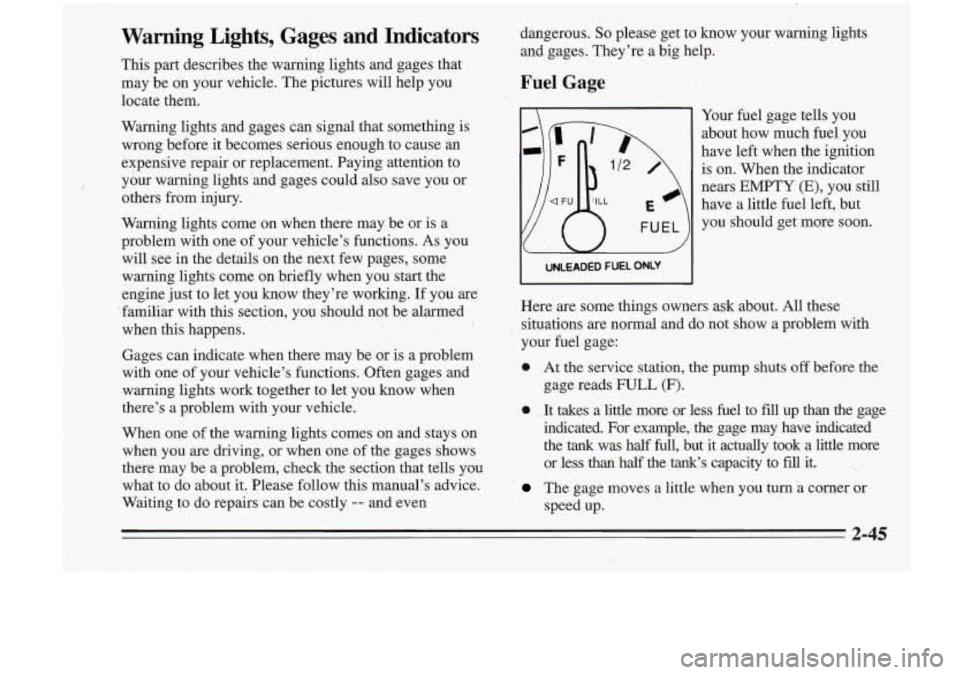
Warning Lights, Gages and Indicators
This part describes the warning lights and,gages that
may be
on your vehicle. The pictures will help you
locate them.
Warning lights and gages can signal that something
is
wrong before it becomFs serious enough to cause an
expensive repair or replacement. Paying attention to
your warning.lights and gages could also save you or
others from injury.
Warning lights come on when there may be or is a
problem with one of your vehicle’s functions.
As you
will see in the details on the next few pages, some
warning lights come on briefly when you start the
engine just to let you know they’re working.
If you are
‘familiar with this section, you should not be alarmed
when this happens.
Gages can indicate when there may be or is a problem
with one-of your vehicle’s functions. Often gages and
warning lights work together to let you know when
there’s a problem with your vehicle.
When one
of the warning lights comes on and stays on
when you are driving, or when one of the gages shows
there may be a problem, check the section that
tells you
what to do about
it. Please follow this manual’s advice.
Waiting to do repairs can be costly
-- and even dangerous.
So please
get to know your warning lights
and gages. They’re
a big help.
Fuel Gage
Your fuel gage tells you
about how much fuel
YOU
have left when the ignition
is on. When the indicator
nears
EMPTY (E), you still
have
a little fuel left, but
you should get more soon.
UNLEADED FUEL ONLY I
I
Here are some things owners ask about. All these
situations are normal and do not show a problem with
your fuel gage:
0 At the service station, the pump shuts off before the
gage reads
FULL (F).
0 . It takes a little more or less fuel to fill up than the gage
indicated. For example, the gage may have indicated
the
tank was half full, but it actually took a little more
or less
than half the tank‘s capacity to fill it.
The gage moves a little when you turn a corner or
speed up.
2-45
Page 113 of 340

Head-Up ,Display (Option)
If you have the Head-Up Display (HUD), you can see
the speedometer reading, in English or metric units,
displayed “through” the windshield.
The HUD
also shows these lights when they are lit on
the instrument panel:
0 Turn Signal Indicators
0 High-Beam Indicator Symbol
Low Fuel Symbol
Oil Warning Symbol
0 Coolant Temperature.Symbo1
Charging System Symbol
I
When you sit straight in your seat, the HUD image will
appear slightly to the right.
When the ignition key is turned to RUN, all possible
HUD images will come on. Then the Head-Up Display
will operate normally.
NOTICE: 1.
Although the HXJD image appears to be near the
front of the vehicle, do not use it as a parking aid. The
.HUD was not designed for that purpose. If
you try to use it that way,-such as in,a parking
lot, you may misjudge distance and run into
something.
J
2-55
. ..
Page 133 of 340
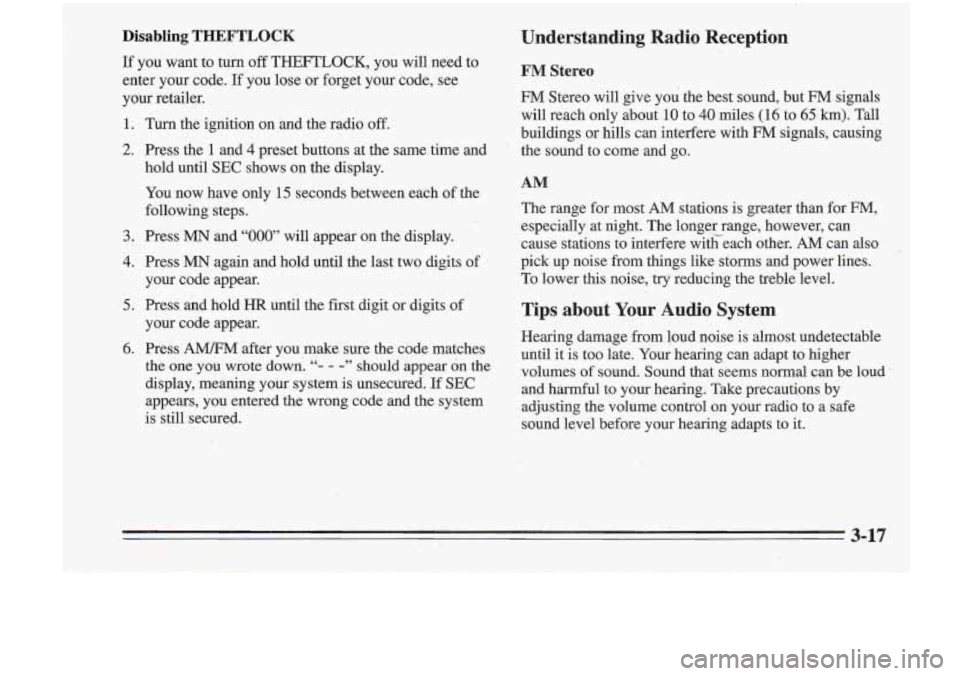
Disabling THEFTLOCK
If you want to turn off THEFTLOCK, you will need to
enter your code.
If you lose or forget your code, see
your retailer.
1. Turn the ignition on and the radio off.
2. Press the 1 and 4 preset buttons at the same time and
hold until
SEC shows on the display.
You now have only
15 seconds between each of the
following steps.
3. Press MN and “000” will appear on the display.
4. Press MN again and hold until the last two digits of
5. Press and hold HR until the first digit or digits of
your code
appear.
your code appear.
4. Press AM/FM after you make sure the code matches
!lie one you wrote down.
“- - -” should appear on the
display, meaning your system is unsecured.
If SEC
appears, you entered the wrong code and the system
is still secured.
Understanding Radio Reception
FM Stereo
EM Stereo will give you the best sound, but FM signals
will reach only about
10 to 40 miles (14 to 45 km). Tall
buildings or hills can interfere with
FM signals, causing
the sound to come and go.
AM
The range for most AM stations is greater than for F”,
especially at night. The longer range, however, can
cause stations to interfere withveach other.
AM can also
pick up noise from things like storms and power lines.
To lower this noise, try reducing the treble level.
Tips about Your Audio System
Hearing damage from loud noise is almost undetectable
until it is too late. Your hearing. can adapt to higher
volumes
of sound. Sound that seems normal can be loud
and harmful to your hearing. Take precautions by
adjusting the volume control on your radio to a safe sound level before your hearing adapts to it.
3-17
Page 150 of 340
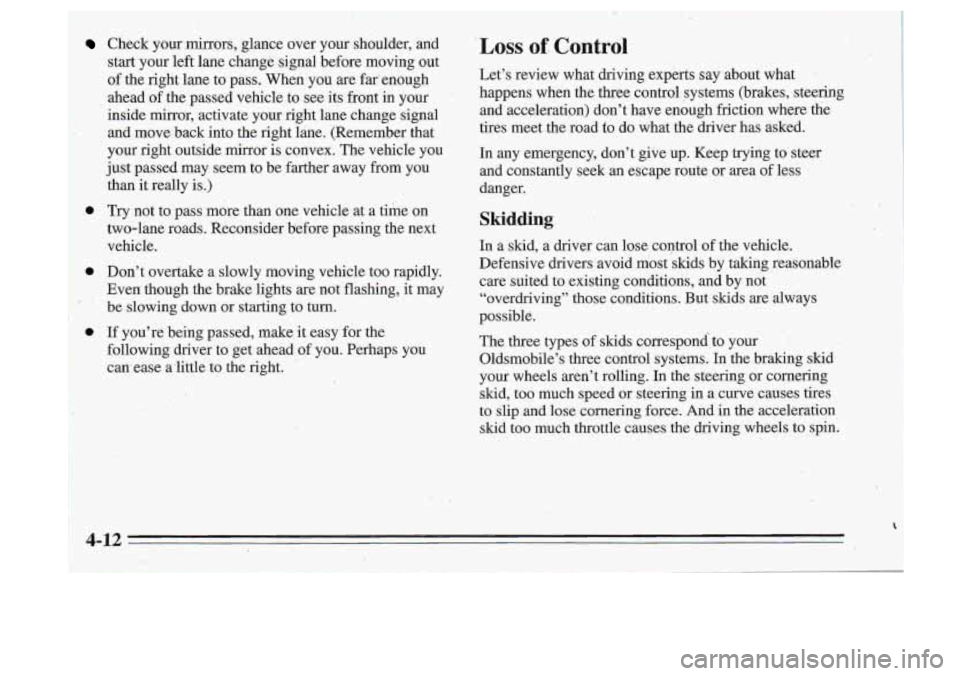
0
0
.. ..
Check your mirrors, glance over your shoklder, and
start your left lane change signal before moving out
of the right lane to pass. When you are far’enough
ahead of the passed vehicle to see its front in your
inside mirror, activate your right$ lane ,change signal
and move back into the right lane. (Remember that
your right outside mirror
is convex. The vehicle you
just passed may seem to be,farther away from
you
than it really is.)
Try not to pass more than one vehicle at a tihe on
two-lane roads. Reconsider before passing the next
vehicle.
Don’t overtake a slowly moving vehicle too rapidly.
Even though the brake lights are not flashing, it.may
be slowing down or starting tu turn.
If you’re being passed, make it easy for the
following driver to get ahead of you. Perhaps you
cmease a,little to the right.
.. : ‘ . .. ~
Loss of Control
Let’s review what driving experts say about what ’
happens when the three control systems (brakes, steering
and acceleration) don’t have enough friction where the
tires meet .the road
to do what ‘the driver has asked.
In any emergency, don’t give up. Keep trying to steer and constantly seek an es-c-gpe route or area
.~f less
danger.
Skidding
In a skid, a driver can lose control of the vehicle.
Defensive drivers avoid most skids by taking reasonable
care suited to existing conditions, and by not
“overdriving” those conditions. But skids are always
possibk.
The three types of skids correspondjo your
Oldsmobile’s three control systems. In the braking skid
your wheels aren’t rolling.
In the steering or cornering
skid, too much speed or steering in
a curve causes tires
to slip and lose cornering force. And in the acceleration
skid too much throttle causes the driving wheels to,spin.
, .*
I
4-12
Page 153 of 340
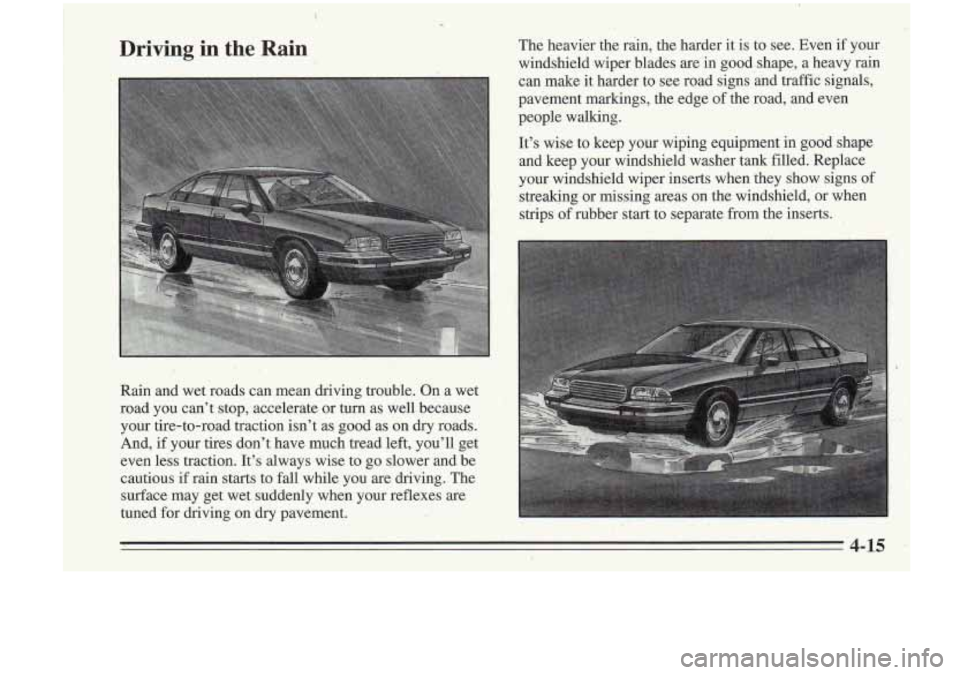
Driving in the Rain
Rain and wet roads can mean driving trouble. On a wet
road you can’t stop, aGcelerate or turn as well because
your tire-to-road traction isn’t as, good as on dry roads.
And, if your tires don’t have much tread left, you’ll get
even less traction.. It’s always wise to go slower and be
cautious
if rain starts to fall while you are driving. The
surface may get wet suddenly when your reflexes are
tuned for driving on.dry pavement. The
heavier the rain, the harder it is to see. Even if your
windshield wiper blades are in good shape, a heavy
rain
can make it harder to see road signs and traffic signals,
pavement markings, the edge of the road, and even
people walking.
It’s wise to keep your wiping equipment in good shape
and keep your windshield washer tank filled. Replace
your windshield wiper inserts when they show signs of
streaking or mising areas on the windshield, or when
strips of rubber start to separate from the inserts.
i
. 4-15
~~ I